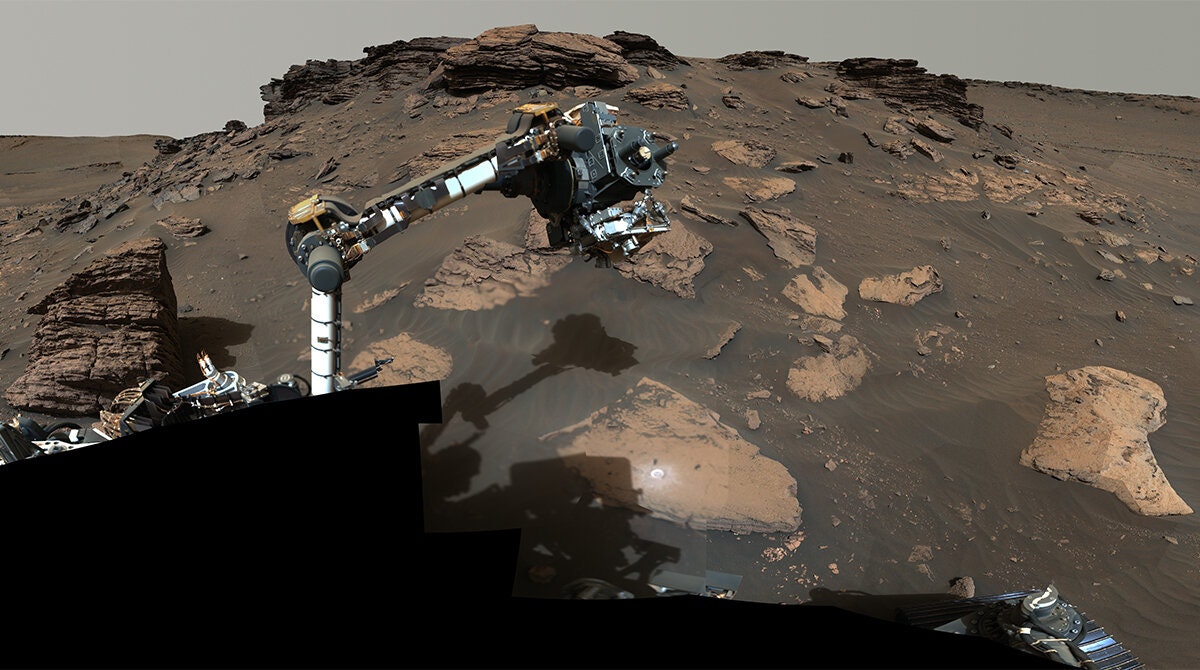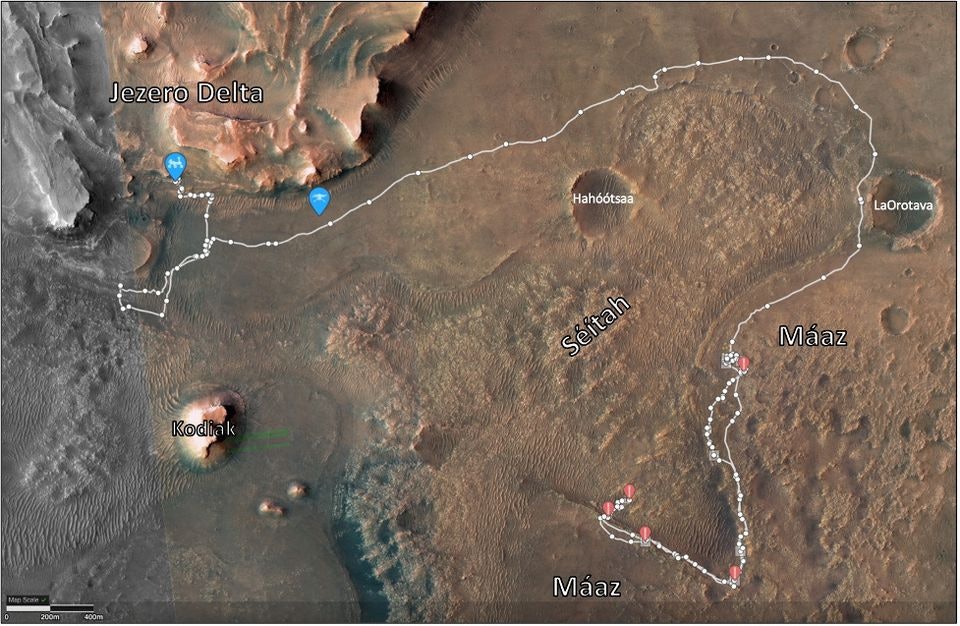
NASA’s Perseverance rover recently shed light on the intermittently watery history of Jezero Crater.
Water flowed through Jezero on and off throughout the roughly 4 billion years since a giant impact formed it. That’s why NASA chose the crater for Perseverance to explore: because it was probably habitable sometime in the past, and may still hold evidence of ancient life. But new data from the rover reminds us that just because there’s water doesn’t mean the environment is hospitable — or familiar.
The water that percolated through the rocky floor of Jezero Crater contained a very different mix of dissolved chemicals at different times. At least two wet periods in the crater’s history left distinct chemical fingerprints in the volcanic rock of the crater floor. And they hint at two very different environments for potential life, including one that we’ve never seen here on Earth.
What’s New — MIT planetary scientist Eva Scheller and her colleagues used Perseverance’s SHERLOC instrument to measure the chemical composition of rock samples from three sites in Jezero Crater. The team published its results in the journal Science.
In the oldest igneous rock on the crater floor — a layer of cooled magma called the Seitah formation — Percy found traces of minerals called carbonates mingled with the grains of olivine that made up most of the rock. And those carbonates are a telltale sign that liquid water once percolated through the rocky floor of Jezero Crater.
“We actually have environments like this on Earth, too,” Scheller tells Inverse. “When you have water flowing through this kind of igneous rock, it’s going to dissolve certain pieces of the rock, and that allows these new minerals like carbonate to form from the liquid water.”
Tucked into the narrow spaces between the olivine grains, Scheller and her colleagues also found traces of amorphous silicate: an oxygen- and silicon- blend with no crystal structure, similar to opal. They also found phosphate, which is a key building block for life; its presence isn’t a sign of life, but it could be a sign of habitability.
But sometime between 3.8 billion and 2.6 billion years ago (a wide estimate based on counting impact craters in the rock), things got weird.
Overlying the Seitah formation is another layer of volcanic rock, a basalt lava flow called the Maaz Formation. Maaz is younger than Seitah, although planetary scientists still aren’t sure exactly how much younger. And the briny water that percolated through it was laden with a mix of chemicals not found in any environment here on Earth.
In voids in the basalt, the brine left behind salts called perchlorates, which contain a negatively-charged ion made of chlorine and four oxygen atoms. That’s not terribly surprising on Mars; the planet’s regolith is laden with perchlorates, and lakes buried beneath the polar ice may also be mostly perchlorate brine, not fresh water. But it’s a reminder that, although Perseverance and Curiosity have found some very familiar features on Mars, it’s an alien world with an alien environment, right down to the chemistry of (at least some of) its groundwater.
“It's basically a very oxygen-rich chemical that is not common to be formed on Earth," says Scheller. “Perchlorate formation in liquid water is quite rare on Earth, if it even happens. This is a very strange type of water chemistry, and we don't know a lot about it, because we don't see it very often on Earth.”
And it's likely that the basalt of Maaz hasn't been touched by water since then. "Perchlorates are easily dissolved, and therefore perchlorates likely formed when these rocks were last exposed to liquid water," the team writes.

Digging into the details — Could either of these wetter past versions of Jezero Crater have provided a home for Martian life? It’s possible, says Scheller, especially in the older Seitah layer.
Sometime before the Maaz layer formed, liquid water percolated through pores in the older Seitah rock formation. But what the data don’t tell us is whether that’s because Seitah was the floor of an ancient lake, or whether the water was fueled by a hydrothermal system. Either scenario could have supported life; it happens here on Earth in very similar environments.
The briny water that left behind perchlorates is a bigger challenge. Previous studies have shown that perchlorates aren’t exactly hospitable to life, and they’re definitely not great at preserving the kinds of evidence of past life that Perseverance is searching for.
“This kind of highly oxygenated state, generally, is not great for preserving signs of life. So I suppose there can always be a possibility, but it's probably not the number one spot you would look for habitable conditions,” Scheller says. “That said, we only have one data point, which is the chemistry of fluids on Earth.”
Why it matters — One very compelling point is that, in samples from both layers of igneous rock, SHERLOC revealed very small amounts of molecules called aromatic organic compounds. They showed up in such small amounts that Scheller and her colleagues couldn’t identify specific compounds, but they include some ring-shaped molecules that may be similar to benzene.
Back in July, NASA planetary scientist Conor Nixon told Inverse why ring-shaped molecules are such a big deal: “If you start looking at amino acids and nuclear bases, they're based around a ring structure,” he said. “The idea of forming rings is very basic and very foundational to making really lifelike molecules.”
Finding these building blocks of life in once-waterlogged Mars rocks could be a tremendous clue for scientists searching for alien life — or it could be a red (planet) herring. Scheller says we may not know exactly what the detection means until the Mars Sample Return mission brings pieces of Seitah and Maaz home for more detailed lab work sometime around 2033.
That’s because the instruments aboard Perseverance, even as advanced as they are, can’t tell whether the molecules it’s seeing are pieces of former microbes, leftover biological waste, or just random byproducts of geological processes.
“Life is organic compounds that are put together in a specific way,” Scheller says, “but if you see organic compounds, that’s not a detection of life.”
What’s Next — But it’s a good reason to take a second look.
“This was like a first look at the data,” says Scheller. She and her team will be spending much more time poring over SHERLOC’s results, and Perseverance will be spending much more time trundling around Jezero Crater to gather more data.
“Right now, we've just been looking at igneous rocks. [Perseverance] is currently collecting data and sedimentary rocks on the lake. And then even when it goes outside the crater, it's going to be collecting rocks from a much older piece of crust,” says Scheller. She hopes to study how liquid water may have interacted with, and changed, those other types of rock at different times in the Martian past.







